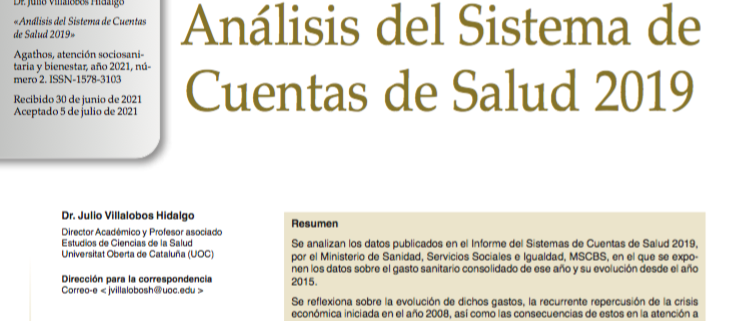Analysis of the Health Accounts System 2019

See PDF of the article:
Cuentas Sistema de Salud 2019.
See PDF of the commented article:
For the seventh consecutive year, a great feat, Julio Villalobos, friend, manager and health analyst, presents us with an analysis of health spending in Spain, based on consolidated expenditures published by the Ministry of Health, consistent with a methodology of analysis accepted by OECD, Eurostat and WHO.
The article that he just published in 2021 (Agathos, nº 2) analyzes the latest information, which corresponds to 2019. It may surprise that in 2021 the data for 2019 will come out, but it is that it is consolidated data.
Therefore, the analysis is pre-COVID-19.
Total health expenditures in 2019 reached 115,458 million euros, with an increase in the 2015-2019 period of 15,748 million, representing an increase of 15.79%. The increase in this period was less in public spending than in private spending.
Total spending in health relative to GDP in 2019 was 9.3%, the same percentage as in 2015.
The total health expenditure per inhabitant/year in 2019 was 2,451 euros, an increase of 14.1% compared to 2015.
Most of the health expenditure in 2019 was used in curative and rehabilitative care, which accounted for 57.54% of the total expenditure.
As in previous years, the low amount dedicated to prevention and public health is striking, a meager 2.11%.
Investments represent 1.55% of total spending in 2019, something totally insufficient to alleviate the accumulated deficit during the years of economic crisis.
Of the expenditure devoted to curative and rehabilitative care, the highest percentage corresponds to outpatient care (51.57%), while 43.62% to hospital care. This corresponds to both public and private care. The trend, already observed in previous years, of greater private financing for outpatients persists.
Regarding pharmaceutical products, the public sector financed 70.16% in 2019, while the private sector financed 29.84%.
Regarding private health spending, 24.20 (8,196 million euros) corresponds to private insurance (with a spectacular growth of 38.07% in the period 2015-2019), while 73.21% corresponds to direct payment from households .
Regarding the destination of direct payment expenses from homes, 52.6% corresponds to medical products and 40.6% to curative care and rehabilitation (the main item in this concept being dental care).
Some conclusions
- Already in 2018, a growth in public health spending began to be seen, after the economic crisis that meant 6 years of decline in health spending. This trend is consolidated in 2019.
- Private spending is mainly made by households in direct payment, which contributes to reducing the purchasing power of families.
- 92.31% of public health spending during 2019 was managed by the autonomous communities.
- Most of the health spending was dedicated to curative and rehabilitation actions, with minimal spending for prevention and public health, as would be evident in the coronavirus crisis, which highlighted the weakness of our health system.
- As for private spending, most of it is direct payments from households. The weight of public funding in dental care, 1.4%, and the purchase of therapeutic devices (hearing aids, glasses, etc.) 5%, is much lower than the EU-28 average, which is situated in 30 and 36% respectively.
- With regard to private insurance, it is found that this expense is related to the level of income. Of the families with less than 1,050 euros net per month, only 4% have contracted private insurance; compared to 41% in families with a net income of more than 3,600 euros / month.
- The investment item, 1.55%, has increased very discreetly. This also takes us away from the average spending in European countries, which invest between 2 and 3% of total health spending only on ICT in health
- The talent deficit is also noted, due to egalitarianism and the poor assessment of the needs and the real worth of the candidates in a statutory, almost civil service regime, where other variables far from the contribution of value influence.
- It is found that the anti-crisis measures have not formed a comprehensive strategy, but rather a succession of measures, which have in common the objective of controlling health spending.
If we want to have a Health System that lasts over time, we must maintain an economic balance between the expenses and the income of the system, paying attention to the causes that originate a growth in health spending and trying to correct them; improve efficiency in the production of services; and adapting the service to new trends in aging and chronicity. - A very important change, which far exceeds what is possible to carry out in a legislature.



